| Part 7 Volubilis, Meknes, Rabat |
|
| Thursday, November 18. The 8th day.
We are going to be busy on a bus today. The distance is about 300 km straight
to the west, stopping over in Volubilis, the ruins in Roman days, and Meknes,
an old city in the 17th century on the way. When we get to Rabat, the capital,
the Atlantic Ocean will appear before the eyes.
In the evening, we go down to the south, aiming at Casablanca, the final
destination of this trip.
Therefore, we left the hotel at the new town in Fez early at 8:30.
It is not quite clear, but slight cloudy, seeming to become fine for the
day.
|
|
| Volubilis |
|
|
I have seen the culture of Roman Empire spread all over Europe during the
travels around Eastern, Western and Central Europe. Not to mention France,
Spain, Czeck and Croatia, I was struck thinking of that even at such a
place when visited Bath in England.
At Alexandria in Egypt, Africa, I traveled back in time to the days of
Cleopatra, when I looked at the ruins and the remains from seabed at a
museum.
In that sense, I have personally been interested in Volubilis. This is
the evidence of Roman Culture at the end of the far west called Maghreb
of Africa, the sunset earth.
Back to the old days, the whole area of Volubilis is said to have become
a subject territory of Roman Empire in the 40s BC and the Roman culture
had been alive here until it withdrew in the result the Berber increased
their power.
We are going to visit this ruins.
|
|
 |
|
|
Among the one-colored places of Islamic culture in Morocco, Volubilis had
a different view no less than my expectation. I came to feel like thinking
of its prosperity and decline 2000 years ago.
The arch of triumph, the remains of the shrine and the public square. They
actually show this place was once a large city. The repair is said to be
on the way, which widens my dream more and more.
The bathroom, the house region and the mosaic of floors. They show some
smell of old life a little. I can't help feeling that each of them is talking
to me.
I just remember the haiku by Matsuo Basho, "Summer grasses. All that
remains. Of warriors' dreams."
Contrary to such sentimental thought, here it is the cross section of the
former prosperity, which makes me associate with Ephesus in Turkey.
The mosaic of the floors are still not sooty but lively. How chic are the
colors! They are not only a couple of places, and also each is not as narrow
as a couple of square meters. Were these kinds of setup a common sense
for a high-society house?
One-hour walking was really short. It was frustrating to listen to the
explanation of the guide through interpretation, and there were too many
ruins and remains to have to see.
We had to leave there with painful reluctance.
|
|
 |
|
 |
|
 |
|
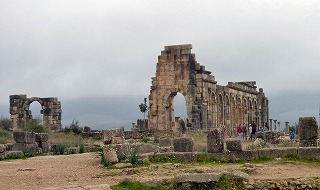 |
|
|
I am just managing to read "The story of the Romans" written
by Nanami Shiono (published by Shincho-sha Co.)
I have read it until the Fall of Carthage, beginning from the birth of
Rome and through Republic Rome, Punic Wars and then the Fall of Macedonia.
In the chronological order, it is only from 8s BC (before the birth of
Rome) to the year 146 BC (the Fall of Carthage). Only 2 volumes out of
the whole 15 volumes. The years 70-44 BC, the days of Julius Caesar, are
far ahead. I am looking forward to getting to the era "All roads lead
to Rome"after the historical picture scroll makes a grand acceleration.
- - - - -
The story has been interesting even until this stage. Especially Hannibal leading Carthage Army with ambition and skillful strategy took a fearless action and commited an act of aggression like raging waves. On the other hand, Scipio Africanus. He rescued Rome on the hook, and laid the foundation for the latter Roman Empire.
The fight of the both heroes, which fascinated me very much as expected.
|
|
| Well, ..., Morocco and Volubilis, the historical ruins.
"The Complete Guide" of Trapics describes as follows on the 1st
line of the brief chronology.
"BC 146 -- The 3rd Punic War ended. Under the rule of Roman Empire."
It was the year Carthage was defeated by the army of Scipio Emirianus,
Scipio Africanus's adopted son-in-law."
The 2nd line says,
"In the 2-3 centuries, Volubilis prospered as the province of Rome."
Volubilis actually became a province of Rome in the year 40 BC and prospered
until the 3rd century.
Even so, Rome in Italian Peninsula separated from African Continent by
the Mediterranean Sea made Algeria and Morocco, the westernmost area of
North Africa, its provinces more than 2000 years ago, not to mention Carthage
(now, Tunisia)! The ruins of Volubilis shows those days vividly.
This is the stage in the days of Paleolithic age or Jomon period in Japan,
several hundred years before the reformation of the Taika Revolution era.
I walked along the ruins with such things running through my mind.
|
|
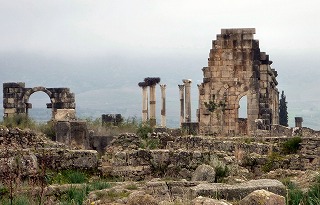 |
|
| Meknes and Rabat |
|
To my regret, I have only a slight impression in Meknes, another World
Heritage.
We arrived there a little over 30 minutes from Volubilis, and saw the sight
for only 1 hour. But, even so, ... |
|
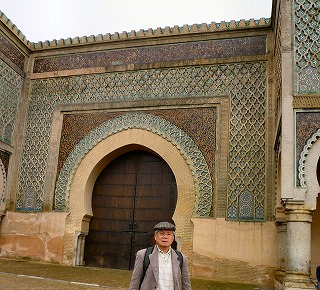 |
|
|
This is it. The above picture is Bab Mansour Gate, the entrance to Medina.
It is closed! Practically the influence by Sacrifice Festival is lasting
even now.
We could not enter Moulay Ismail Mausoleum either.
We spent 1 hour reluctantly in a variety market. During the blind purchase
of figs and date palms, I totally forgot this spot was the old town of
World Heritage.
After back home, I noticed the following from a guidebook.
It says, "In this town prospered in the 17th century, you should never
fail to visit Medina with important cultural assets. Especially Moulay
Ismail Mausoleum is one of the best beautiful architectures."
Since it was closed because of the special event, even Trapics could not
have helped giving up. No one of the group including me grumbled at anything,
while appreciating the variety market.
|
|
 |
|
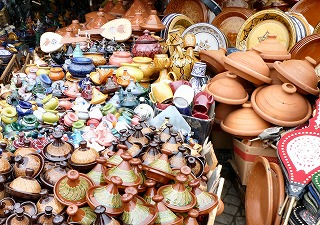 |
|
After the lunch of squid tajine meal, we headed for Rabat for 2 hours.
Rabat is a big city with the population of 1,200 thousand people, facing
the Atlantic Ocean. |
|
|
How long does Sacrifice Festival continue? At least from my real feeling
during this trip, we were not able to see some places of interest enough
both on the next day and the day after next in Casablanca, and several
stores and markets were closed in every town, especially deserted in Medina.
|
|
|
Rabat has another name of Garden City. Is the quiet atmosphere here same
as usual?
It may depend on the sights we visited, but I felt this town so noble and
majestical compared to others. It may also be because we did not enter
Medina only in this city.
It is rather unfair that we did not touch the real Morocco not Europeanized,
but I felt touching the capital of the kingdom.
|
|
 |
| Entrance to Mausoleum of Mohammed V |
|
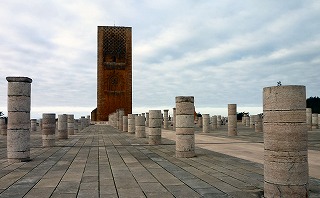 |
| Tour Hassan (Hassan Tower) |
|
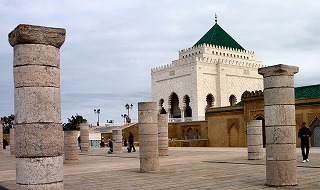 |
| Mausoleum of Mohammed V |
|
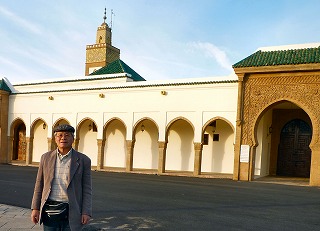 |
| Royal Palace of Mohammed 6 |
|
| Other Pictures |
|
|
|
| Reading: 13:51 |
|

